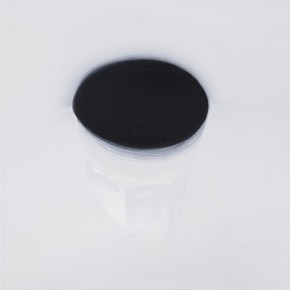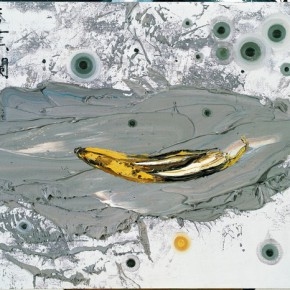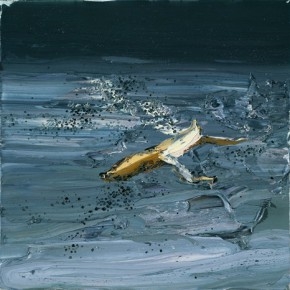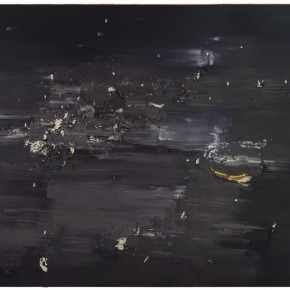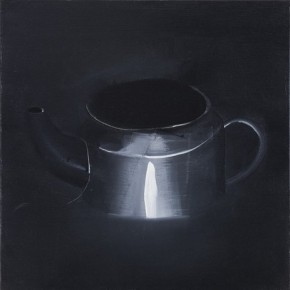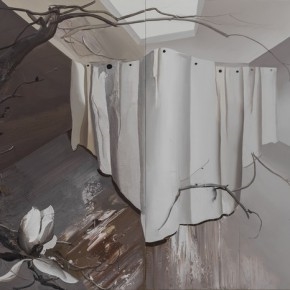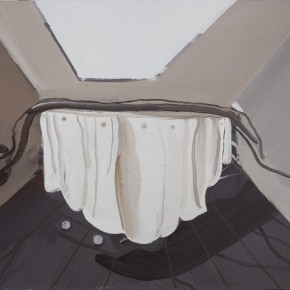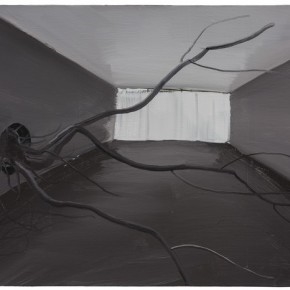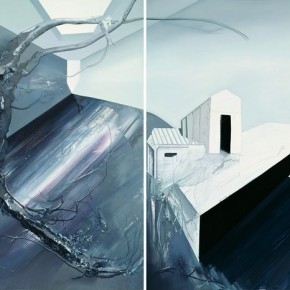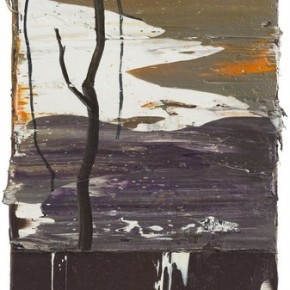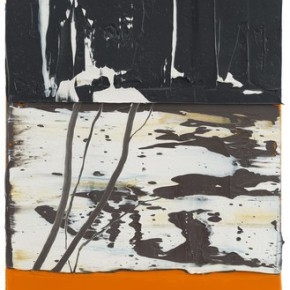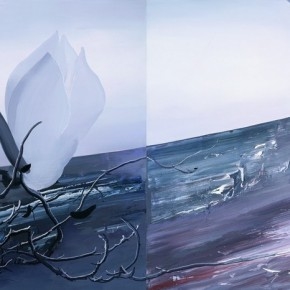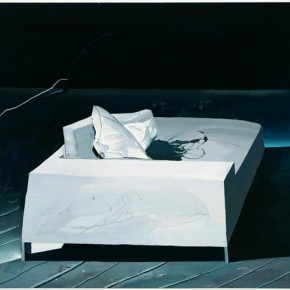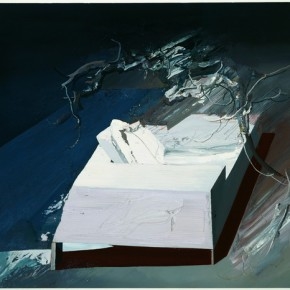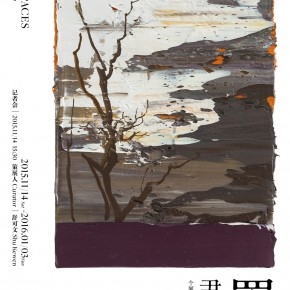
Multispaces: Yin Qi’s Painting Exhibition
By Shu Kewen, Former Deputy Editor of Sanlian Life Week, Curator
In his defense of modern abstract painting, Fry called it a heroic attempt, while not denying how the appeal of modern abstract works can be limited due to certain issues. Now, this is considered an outdated problem because the rich and flourishing artistic practices over the last century have either evolved beyond these issues, changed them entirely, or become muddled by new ones. Here, there indeed lies many forks in the road ahead that present a myriad of practical and urgent situations. Yin Qi has stated that he started with the practice of installations before returning to the source of this problem, old as it may be. He says that observations of this material world still has room to grow. And, to him, “The re-cognition of material space is like the biggest form of politics”, a principle that he displays in his paintings.
While studying in Paris in the 1990s, Yin Qi created the installation works, Daily Stroll and Garden Path, which marked the start of his processing and re-understanding of the problems with space. A decade later, he began painting again. In truth, form is not important. What is important is how to materialize the problems mentioned and felt using what space, weight, and image to answer the question, “What is image?” That is indeed an idea that is hard to resist, using a revised and visible world to realize dreams. However, no matter how physically big they get, they might possibly not be any of his problem.
Regarding early modernism, Fry questioned whether it existed in two categories of paintings. The first is so-called pure painting, which is an intellectual appeal through an arrangement of forms. The other is painting materialized through a subject, using methods similar to literature to evoke conceptual and emotional associations. Regarding these two types of paintings, Bacon, Richter, and others all conducted an integration of practices. If one were to say that Mondrian’s abstract paintings were not created through the visual observations of a subject, Mondrian himself has even said, “There is nothing more abstract than what I can see with my eyes.” The abstract that he mentioned also includes abstract geometry, but they are organic geometry depicted through images. Yin Qi brings up two examples to contrast his reflections regarding this issue: Ni Zan and Morandi. Through a combination of constrained objects, they form an infinite sense to the world, painting visualized and visible objects that also belong to another reality. This happens to be one of the objectives for creating art. “Artists should create other realities. At the fork in the road for modernist paintings, I return to the image on the canvas and pay tribute classicism - not just the classicism for oil painting, but also that of traditional Chinese paintings.”
Across the picture, his problems with space change once more. The space that he processes for his installation works is basically the multiple relationships between people/bodies and space: pass and obstruct, inner and outer, explicit and implicit, etc. On the picture, the problems of space become more than just that. Here, a type of non-continuous space can appear that interweaves the intervention of objects and the world. In such works as Magnolia and Banana Sky, each part of the picture is not dependent on the existence of something else. At least, through perspective, they reside in a different space, yet exude a cycle of breath here that enables them to exist interdependently in the exchange of an even more powerful message. The level of gray suggests associations with Chinese ink painting. In fact, we find it difficult to rid ourselves of the habit of culture. Yet, in habits, one must not lose out on opportunities for re-comprehension that allows the transformation of new opinions. In Banana Sky, black spots on a banana resemble stars in the sky.
Yin Qi said that he intended to paint the sky. Yet, the result is not a figurative or abstract representation of the sky. “In fact, there is no one way to depict the sky. The sky is so vast and incomprehensible that it holds a different meaning for everyone. The ancient Chinese would paint orchids or stones as representations of the sky.” Every object, including physical objects and even air, that Yin paints has its own narrative. Does this change the nature of realism? His works not only captures what the eyes sees but also what the mind senses, which constructs a new kind of reality.
Here, he wants to rediscover that kind of divinity. This is a perspective that is longed for by many people. That world is not an object of desire nor one that can be changed by one’s will. It is a realm where one resides within, a realm where the consciousness and universe is one. In the modern world, mankind can produce what nature cannot. So, in this new realm, how do we take into consideration man made creations, asks Yin Qi. “Those who practice traditional Chinese landscape paintings must not ignore this fact. When the ancient Chinese painted a stone, they weren’t really painting a stone. When I paint a sofa, I am not really painting a sofa, but I am expressing myself and my state of mind. It is like I am designing my own body. Be it a sofa, or any piece of furniture, they all have their place in our universe. Who cares if they are man made or not.”
For his university thesis, Yin Qi wrote about the topic of a second nature. In the paper, he discussed how mankind should form a relation with modern man made objects. “In reality, this is impossible, as an artificial environment is after all different from a natural one. However, from the perspective of an attitude or state of mind, why not? This discussion prompts us to not let our consciousness be obstructed by man made objects, so that art does not lose its spirituality.”
This reassembled awareness is distinct from an original or generated image. In terms of the creative method, the artist creates collages that are not stirred nor crisscrossed. Modern art effects are not rejected, yet traditional methods are still adhered to. Yin Qi asks, “Then, does this image have a visual construct?” Through an innovative creative approach, Yin Qi has created many oil works, both large and small. They are not the result of an idea because the painting process is a process of focus. During this process, fleeting thoughts merge. The artist intentionally uses absolute realistic or abstract techniques to express a worldly consciousness. With mind and universe as one, consciousness becomes ominous. In such a painting, light shines on places where the mind focuses on. Space is no longer what separates people, objects and environments. In fact, this is not a one time process, but an adjustment of one’s mindset. Mass accumulated through the gathering of many smaller units lead to the creation of a large composition. This is not a personal revolution, but the result of many endeavours that progress in tandem and that lead to a more complete understanding.
October, 2015
About the exhibition
Date: 14/11/2015 - 03/01/2016
Curator: Shu Kewen
Venue: Soka Art Center, Beijing
Courtesy of the artist and Soka Art Center.


